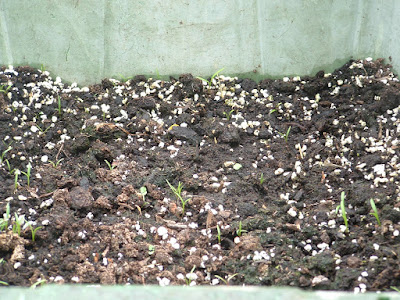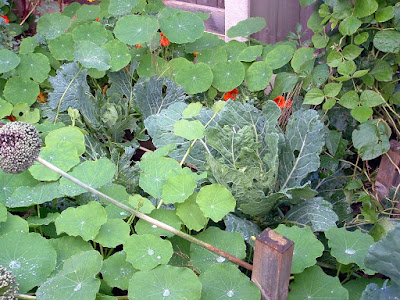 |
| Seed trays and containers on the patio, April 2017 |
My gardening manual,
The Complete Guide to Self Sufficiency, by John Seymour, advocates a separate bed just for sowing seeds to be transplanted out. My regular garden year book suggests this too, as do the backs of various seed packets. I haven't made such a bed, since previous years' experience has taught me that direct-seeded plants rarely survive in my garden. There are a few exceptions (chard and mizuna have self seeded pretty successfully this spring), but most of my seedlings either get mown down by slugs very early on, or just never appear at all.
I try to raise most of my vegetables and annual flowers as transplants, to give them a better chance of surviving slug attacks. Some of these are tender and raised indoors first (tomatoes, cucumber, etc), but a lot can be sown in trays outdoors this month. I keep them high up, like on a table, to minimize slug attacks; like being directly in the ground, they're just as vulnerable in a tray if it's on the ground too.
For the most part I space the seeds at regular intervals in the trays, unless the seeds are too small to handle, like celery or snapdragons; these are broadcast, but I try to limit their numbers to around 20-30 seeds per tray. It's really easy to accidently tip out a hundred of these tiny seeds, and they're a real pain to prick out when all clustered together.
 |
| Carrot seedlings in a container, April 2017 |
Pricking out: when seedlings have grown a true leaf or two, I will try to prick out these little plants into regular spacing, usually into a new tray to make it easier on myself. In February I sowed a tray with a third each of lobelia, snapdragons, and tobacco flowers, then went on to prick them out into their own separate trays. After I pricked out all the plants I could possibly want--about 30 of each, including some for gifts--I tipped out the remainder into the compost.
As for the seedlings which I'm able to space regularly in the trays: brassicas, leeks, etc, I try to grow these on in their trays until they become fat little plants and transplant them into the ground. They're usually around 2 inches apart in their trays, giving them enough room to grow for about 6 weeks before needing more space anyway.
There's one vegetable I grow exclusively in containers, and that is carrots (I have the double whammy of slugs
and carrot fly). These I broadcast and don't bother pricking out. I'll thin them out as they grow bigger, and eat the thinnings--or the seven year old will, or the husband will...they're very popular here.










